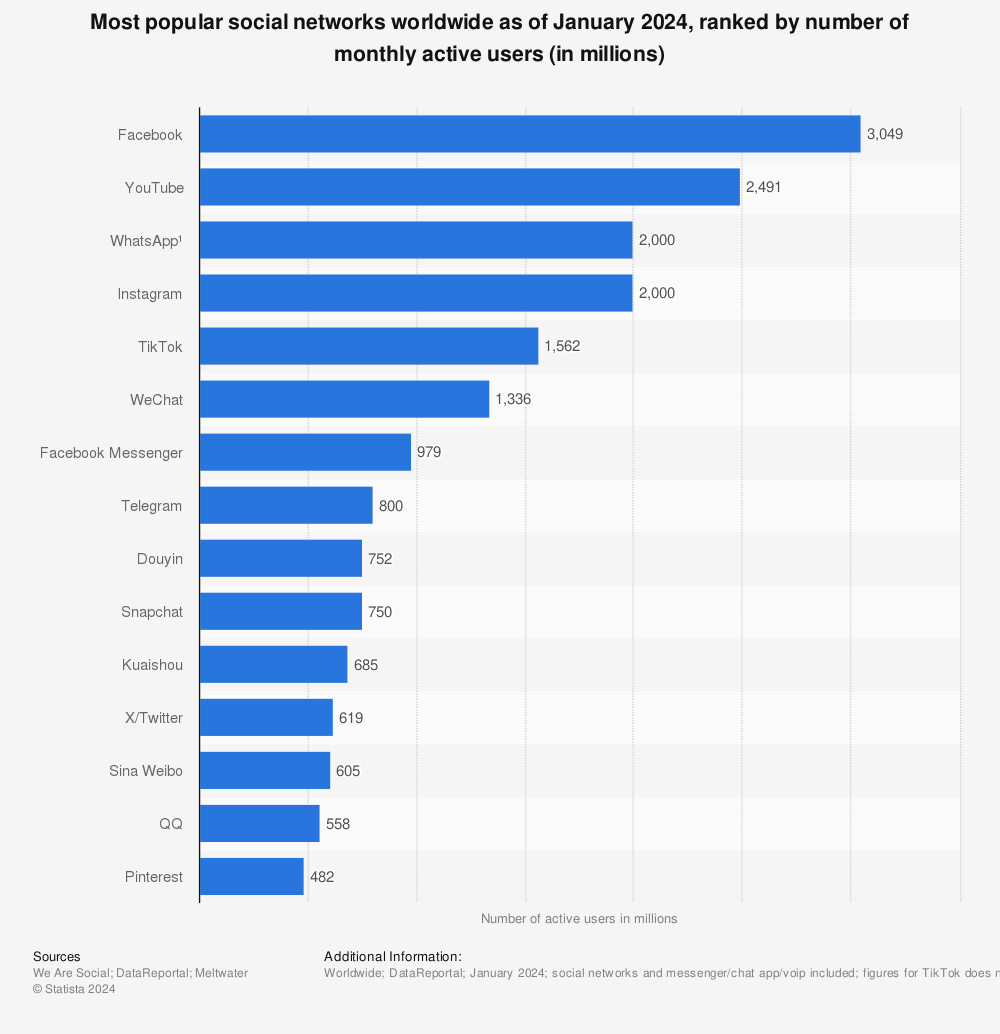As of early 2025, the world of social media is more crowded than ever, with approximately 5.24 billion active users across the globe. That's a staggering 63.9% of the entire human race, a figure that grew by 4.1% in the last year alone.
As you'd expect, the biggest players are household names. Meta's empire is vast, with Facebook boasting over 3 billion monthly active users (MAUs), WhatsApp connecting another 3 billion, and Instagram engaging over 2 billion. And that's before we even mention video giant TikTok, with its 1.5 billion MAUs.
Scan a little further down the list, however, and you might encounter some distinctly less familiar names. Are you one of Viber's 260 million members? Signed up to QQ? Au fait with WeChat? For those of you who are in the dark, here's a closer look at some of the most popular international social networks that many of you may never have heard of.
Find more statistics at Statista
Tencent QQ - 534 million users
Tencent QQ, or QQ as it is popularly known, is a titan of the Chinese social media scene. While its user base has seen a slight dip, it still commanded 534 million monthly active users on mobile devices in the first quarter of 2025. QQ is a web-based instant-messaging service, featuring text and video messaging, voice chat, and file sharing. The app runs on operating systems including Microsoft Windows, Android, and iOS.
The platform's business-focused branch, QQ Enterprise, allows brands to promote their products and services to the network's vast user base.
"QQ" can mean "cute" in Chinese online slang, and a scarf-toting penguin mascot reinforces the platform's friendly persona. Some civil liberties commentators have argued that the company's compliance with government-enforced user surveillance and censorship is anything but cute and cuddly, but privacy concerns relating to social media platforms are far from an exclusively Chinese problem.
Tencent also operates the world's biggest social platform outside of the Meta ecosystem: WeChat, with its colossal 1.38 billion user base.
Baidu Tieba
Baidu Tieba, the leading social platform from China's top search engine, is quite unlike any other social network. It's essentially a vastly popular forum, built around search functionality. While specific user data for Tieba is not readily available, the main Baidu App it's integrated with reached a staggering 724 million monthly active users in the first quarter of 2025.
It all starts with a search. The user enters their query into the search bar and is then directed to a selection of editorialised discussion threads (known as 'bars') based on their search. If the query doesn't match any existing bars, a new bar is created. Members of the Baidu Tieba community moderate activity on each bar as 'masters', 'vice-masters' or 'video-masters'. Imagine a bowdlerised Wikipedia-Reddit hybrid built around search functionality and you'll be somewhere close to a mental image of this intriguing platform.
Viber - 260 million registered users
Viber may not be the most interesting platform on this list from a B2C perspective, but it's certainly worth knowing about. Launched in December 2010 by a team of business partners from Israel and Belarus, Viber is a free-to-use VoIP (voice over internet protocol) app offering voice and text messaging. As of May 2025, it had 260 million registered users, though its active user count isn't publicly disclosed.
The app also supports in-app calls to international landlines for highly competitive rates , a feature which has fuelled popularity amongst migrant workers and long-term travellers.
Viber was always intended as a direct competitor to Skype, and in many users' eyes it is in fact the superior product. Unlike its Microsoft-owned rival, Viber was designed specifically as a mobile app, which gives it a natural edge in terms of mobile functionality.
Sina Weibo - 591 million users
They say imitation is the highest form of flattery. That being the case, the team behind X (formerly Twitter) must feel exceptionally flattered by Chinese microblogging network Sina Weibo. With 591 million monthly active users as of March 2025, its scale is immense.
"Weibo" lets you follow hashtags and user accounts, re-post content from other users, and create text or rich media posts of your own. There's also a 140-character limit on each post…
That's not to say China's top microblogging platform doesn't have some nifty features of its own. Sina Weibo's most interesting feature for digital marketers is its reward system, which awards medals to users based on how they interact with the network. Brands including Nike and Transformers have teamed up with Sina Weibo to offer special medals to users who re-tweet their content – a prime example of gamification in digital marketing.
VKontakte (VK)
Social start-ups take note: Western platforms are not necessarily the dominant force wherever they operate. Throughout much of Eastern Europe, and especially Russia, the leading social network is VKontakte, or VK. Bear in mind the site was banned in Ukraine after Russia invaded teh country.
In the first quarter of 2025, VK's average monthly audience in Russia reached 92.9 million users. In a landmark shift, its monthly reach in the country even surpassed that of YouTube in late 2024, due to the blocking of other social media channels by the Russian government.
VKontakte is similar to Facebook in many ways, from posts and profiles to likes and shares, but there are some subtle differences at play. For one thing, messages can be sent to email addresses as well as other profiles, and comments can be left via SMS. Profile details are also more detailed, alongside your basic information you'll be able to list details ranging from your political beliefs to your military service record!

